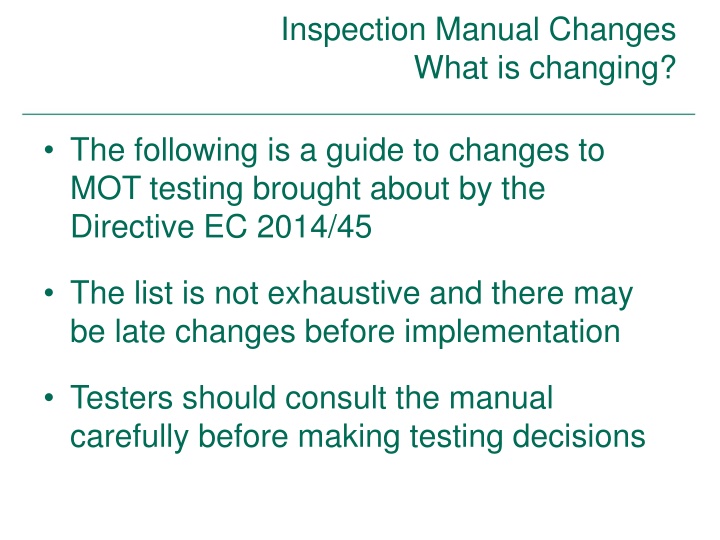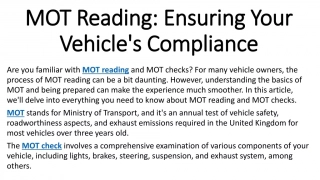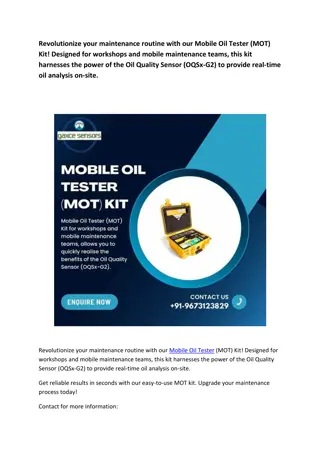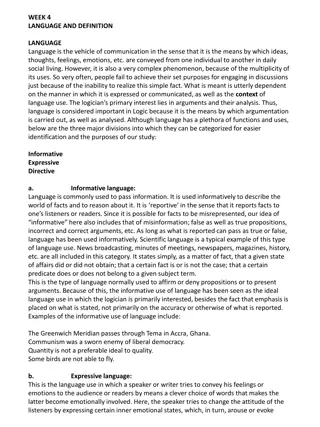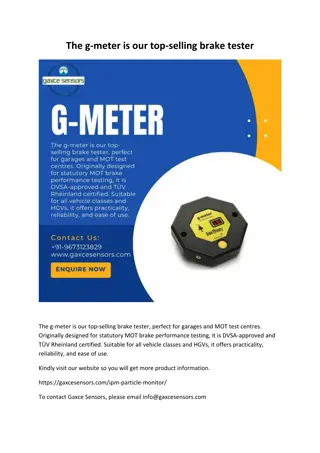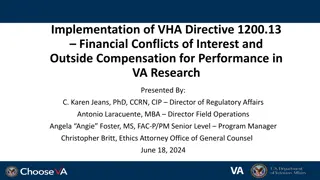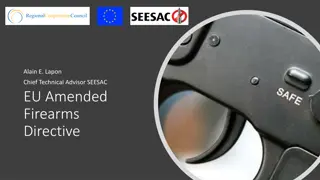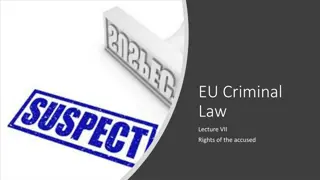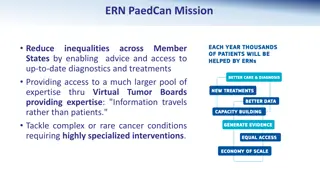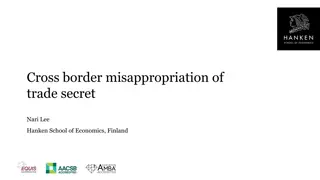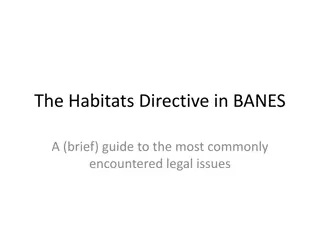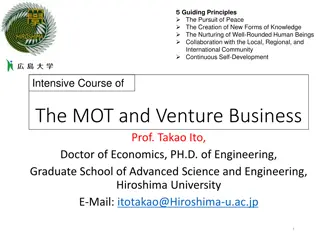Changes to MOT Testing Manual Due to Directive EC 2014/45
The upcoming changes to the MOT testing manual, influenced by Directive EC 2014/45, are outlined. The manual will transition into an online service, and the sequence of sections will be reorganized. Key areas of focus for testing include brakes, steering, visibility, lamps, electrical equipment, axles, wheels, tires, suspension, body, structure, equipment, and more. The adjustments aim to ensure vehicles meet necessary safety standards.
Download Presentation

Please find below an Image/Link to download the presentation.
The content on the website is provided AS IS for your information and personal use only. It may not be sold, licensed, or shared on other websites without obtaining consent from the author.If you encounter any issues during the download, it is possible that the publisher has removed the file from their server.
You are allowed to download the files provided on this website for personal or commercial use, subject to the condition that they are used lawfully. All files are the property of their respective owners.
The content on the website is provided AS IS for your information and personal use only. It may not be sold, licensed, or shared on other websites without obtaining consent from the author.
E N D
Presentation Transcript
Inspection Manual Changes What is changing? The following is a guide to changes to MOT testing brought about by the Directive EC 2014/45 The list is not exhaustive and there may be late changes before implementation Testers should consult the manual carefully before making testing decisions 1
Inspection Manual Changes Introduction Why are we changing the manual when we are coming out of the European Union? The UK was a full member when the Directive was written and will still be a full member when it is implemented Fines for the UK Risk that UK vehicles without a compliant MOT would not be allowed in the EU 2
Inspection Manual Changes Introduction The physical test changes very little 3
Inspection Manual Changes What is changing? The manual as we know it will no longer exist The manual will be an online web service The sequence has changed and there are more sections 4
Inspection Manual Changes What is changing? Section 0; Identification of the vehicle (Number plates and VIN) Section 1; Brakes Section 2; Steering Section 3; Visibility Section 4; Lamps, reflectors and electrical equipment Section 5; Axles, wheels, tyres and suspension 5
Inspection Manual Changes What is changing? Section 6; Body, structure and equipment Section 7; Other equipment (Seat belts, SRS, Speedometer, Horn Electronic Stability Control) Section 8; Nuisance (Noise, Emissions, Environmental items) Section 9; Supplementary tests for buses and coaches (Includes Class 4 and 5 minibuses) Section 10; Seat belt installation tests 6
Inspection Manual Changes What is changing? Appendix A; Structural integrity and corrosion Appendix B; Tyre load index tables Appendix C; Seat belt fitment tables 7
Inspection Manual Changes What is changing? Defect Categories Dangerous Major Minor Advisories Pass 8
Inspection Manual Changes What is changing? Dangerous defects Indicate that the defect is so severe that the customer would be advised that the vehicle should not be driven until the defect is repaired 9
Inspection Manual Changes What is changing? Major Defects - are serious fails, which are not dissimilar to the old reason for rejections (RFRs) that we have become used to 10
Inspection Manual Changes What is changing? Minor defects Less serious defects the vehicle still passes Defects must be identified Some minor defects were previously RFRs and vice-versa 11
Inspection Manual Changes What is changing? Manual Advisories The eventual intention is to remove manual advisories altogether 12
Inspection Manual Changes What is changing? The following is intended as a guide only and is not an exhaustive list of all of the changes that may be encountered. The tester is expected to check every defect to ensure that the correct testing decisions are made. 13
Inspection Manual Changes What is changing? Previous RFRs now Minor defects Brake fluid level below minimum mark Brake fluid warning lamp illuminated or inoperative Power steering fluid below minimum mark Trailer electrical socket insecure Direction indicator flashing rate Registration plate lamps missing or inoperative in the case of multiple lamps or light sources. (as long as one remains operative) Several audible warning defects (indicators) Many items insecure but not likely to become detached 14
Inspection Manual Changes What is changing? Vehicle Classifications Simpler European Classifications M1; Passenger vehicles (4 wheels) not more than 8 passenger seats N1; Goods Vehicles up to 3500kg (DGW) (Can still only test Class 7 if authorised) There will be a new certificate, which will include the new classifications 15
Inspection Manual Changes What is changing? Dual Purpose Vehicles Definition in the guides remains but: Unladen weight must not exceed 2040kg Where there is no unladen weight:- 4 x 4 pick-ups with DGW 3000 3500kg to be considered as dual purpose (M1) 16
Inspection Manual Changes What is changing? American Pick ups (manufactured in USA or Canada) DGW between 3000 - 6500kg test as Class 4 (No European classification) Testers can only test vehicles on authorised equipment if too large, must decline 17
Inspection Manual Changes What is changing? Pick up trucks with a 5th Wheel Not to be treated as HGVs Class 4, Class 7, dual purpose or American Pick up 18
Inspection Manual Changes What is changing? Other areas of note in the introduction Information about Vehicles of Historic Interest added (over 40 years old) Reason to refuse to test for presence of a load added Definition of insecure added Definition of unsafe modification added Changes to extensively modified vehicles to include modifications for disabled use 19
Inspection Manual Changes What is changing? Identification of Vehicle (Section 0) Checks for two different VINs removed New failure for VIN obviously falsified 20
Inspection Manual Changes What is changing? Brakes Remember that Class 4 can be large vehicles, be careful not to confuse these for cars & LGVs:- Slack Adjusters Spring Brakes Actuators Air dryers Antifreeze pumps Endurance braking systems Air and vacuum systems (Not vacuum assisted) 21
Inspection Manual Changes What is changing? Brakes (section 1) New failure for brake lining or pad wear indicator New failure for brake lining/pad incorrectly mounted New failure for a brake disc or drum missing ABS system cannot be removed post 2010 vehicle New failure for brake fluid contaminated (Visual assessment, without removing the top) Checks for reserve pressure of full power hydraulic systems removed 22
Inspection Manual Changes What is changing? Steering (Section 2) New failures for sector shaft condition New failure for steering gear fixing holes elongated New failures for electronic power steering wiring damaged or corroded New failure relating to fly by wire steering systems 23
Inspection Manual Changes What is changing? Axles, Wheels, Tyres & Suspension (Section 5) The following RFRs no longer apply:- Failure for fitment of space-savers removed Checks of tyre valves removed Checks for tyre correctly seated on the bead rim removed Checks for tyre structure between axles removed 24
Inspection Manual Changes What is changing? Tyres New fail Tyre obviously underinflated Stretched tyres - not a fail but check for sidewall damage Tyre tables moved to Appendix B Suspension New fail - A spring missing 25
Inspection Manual Changes What is changing? Body, Structure & Equipment (Section 6) Vehicle structure now fails if its rigidity is significantly reduced New checks for strengthening plates and fastening Exhaust fumes entering cabin failure extended to all vehicles (not just Class 5) Information about fuel tanks holed above the fuel line added New failures for fuel tank and exhaust shields missing when there is a fire risk New failure for any part of a gas fuel system defective 26
Inspection Manual Changes What is changing? Body, Structure & Equipment (Section 6) New failures for bumper security New failure for spare wheel carrier condition New failures for tow bar safety devices and coupling indicators Inspection of drive shafts extended to all transmission shafts, including prop shafts Inspection now includes drive belts and chains Inspection of body condition now includes unsafe modifications, component security, including under trays as well as body pillars on goods vehicles 27
Inspection Manual Changes What is changing? Body, Structure & Equipment (Section 6) New failures for cab security New failures for floor condition New failures for seat structure condition New failures for cab steps New failures for footrests and handgrips (This inspection only applies to vehicles fitted with hand grips and/or footrests for the driver/passenger(s), quads and trikes) 28
Inspection Manual Changes What is changing? Lamps, Reflectors and Electrical Equipment (Section 4) New failures for daytime running lamps (DRLs) (Vehicles 1st used on or after 1st March 2018) New failures for front fog lamps (Vehicles 1st used on or after 1st March 2018) 29
Inspection Manual Changes What is changing? Lamps, Reflectors and Electrical Equipment (Section 4) New failures for reversing lamps (Check from 20th May onwards for all vehicles first used after 1st September 2009 one or two may be fitted but all must work minor failure) 30
Inspection Manual Changes What is changing? Lamps, Reflectors and Electrical Equipment (Section 4) New failure for light source and lamp not compatible (HID lamps fitted to halogen headlamp units) Headlamp washers tested on vehicles (when fitted) first used on or after 1 September 2009 31
Inspection Manual Changes What is changing? Lamps, Reflectors and Electrical Equipment (Section 4) Information added about the interaction between position lamps and other lamps. Where the role of the front position lamp is carried out by the DRL, they may dim when the rear position lamps are switched on and may extinguish when the headlamps or front fog lamps are illuminated. 32
Inspection Manual Changes What is changing? Lamps, Reflectors and Electrical Equipment (Section 4) Inspection of end-outline marker lamps now applies to Class 4, 5, and 7 where the vehicle width exceeds 2.1 metres 33
Inspection Manual Changes What is changing? Nuisance (Section 8) Nuisance is a new section that includes; Noise Exhaust emissions Fluid leaks 34
Inspection Manual Changes What is changing? Noise Subjective assessment of noise (as before) A new term noise suppression refers to silencers and under bonnet noise deadening material fitted as original equipment (not applicable to Class 3 vehicle). If these are insecure, they are major defects or dangerous defects if likely to become detached. 35
Inspection Manual Changes What is changing? Spark Ignition (petrol & gas) New fail:- Any emission control equipment fitted by the manufacturer is missing, obviously modified or obviously defective is a major fail, as is an induction leak that could affect emission levels. 36
Inspection Manual Changes What is changing? Spark Ignition (petrol & gas) Emission levels remain unchanged for spark ignition engines New Change:- A check of the Engine Malfunction Indicator Lamp (MIL) is required. 37
Inspection Manual Changes What is changing? Compression Ignition (Diesel) As with spark ignition, any Diesel Particulate Filters (DPF), Oxidation Catalyst or Selective Catalyst Reduction (SCR) valve that have been removed, obviously modified or defective will be a major fail 38
Inspection Manual Changes What is changing? Compression Ignition (Diesel) There is no fast pass although if after the first acceleration, the smoke level displayed on the meter is equal to, or less than the limit for the vehicle, the vehicle has passed the opacity test and a pass result will be displayed on the meter 39
Inspection Manual Changes What is changing? Compression Ignition (Diesel) Pre 1980 vehicles a visual check (see manual for details on how to perform this) Post 1980 vehicles - first used after 1980, check the emission level on the manufacturer s plate (if it is shown) for example 0.8 and use this value. 40
Inspection Manual Changes What is changing? Compression Ignition (Diesel) If the plate does not include the emission level, then for any vehicle first used before 1st July 2008, (and after 1980); for non-turbocharged engines, not more than 2.5m-1 and for turbocharged, not more than 3.0m-1 41
Inspection Manual Changes What is changing? Compression Ignition (Diesel) For vehicles first used on or after 1 July 2008 (non-turbocharged or turbocharged), -not more than 1.5m-1 For vehicles first used on or after 1 January 2014 (non-turbocharged or turbocharged) - not more than 0.7m-1 (remember that in all cases post 1980, the plate value must be used if available) 42
Inspection Manual Changes What is changing? 43
Inspection Manual Changes What is changing? Compression Ignition (Diesel) If the vehicle is fitted with a DPF and emits smoke of any colour, this is a major defect As with petrol engines, the MIL is now part of the test and will be a major defect if it is inoperative or indicates a malfunction 44
Inspection Manual Changes What is changing? Fluid Leaks A new section that covers all leaks but excludes engine coolant, screen wash and Selective Catalyst Reduction (SCR) fluid. Note: Many sections of the manual have their own defect categorisation for leaks, e.g. Power Steering. Leaks are considered excessive if they deposit more than a 75mm diameter pool in 5 minutes (collectively). For leaks to fail, they must pose an environmental threat, so discharges from air conditioning units (water) would not be included. 45
Inspection Manual Changes What is changing? Visibility & Other equipment The field of vision from the driver s seat has been clarified The driver s field of vision through the windscreen and front side windows must be assessed from the driver s seat and rejection is only justified if the driver s view is materially affected. If it only affects the driver s view of the sky or the bonnet then it does not justify rejection. 46
Inspection Manual Changes What is changing? Visibility & Other equipment you are not required to speculate on the effects on tall or short drivers The view of the exterior mirrors is also included but not the view through the mirrors, which has its own criteria. A wiper blade missing or obviously not cleaning the windscreen is a major defect 47
Inspection Manual Changes What is changing? Visibility & Other equipment A wiper blade missing or obviously not cleaning the windscreen is a major defect A new failure for excessively tinted glass (including side window when affecting view of obligatory external mirror) Class 5 glazing now only applies to vehicles first used from 1 June 1978 and no longer applies to interior doors or panels 48
Inspection Manual Changes What is changing? Other Equipment New failure for seat belt not functioning as intended or incorrect type Speedometer; Speedometer operation is not normally checked unless a road test is required eg decelerometer test. In this instance, the speedo operation must be checked and if not working, is a major defect 49
